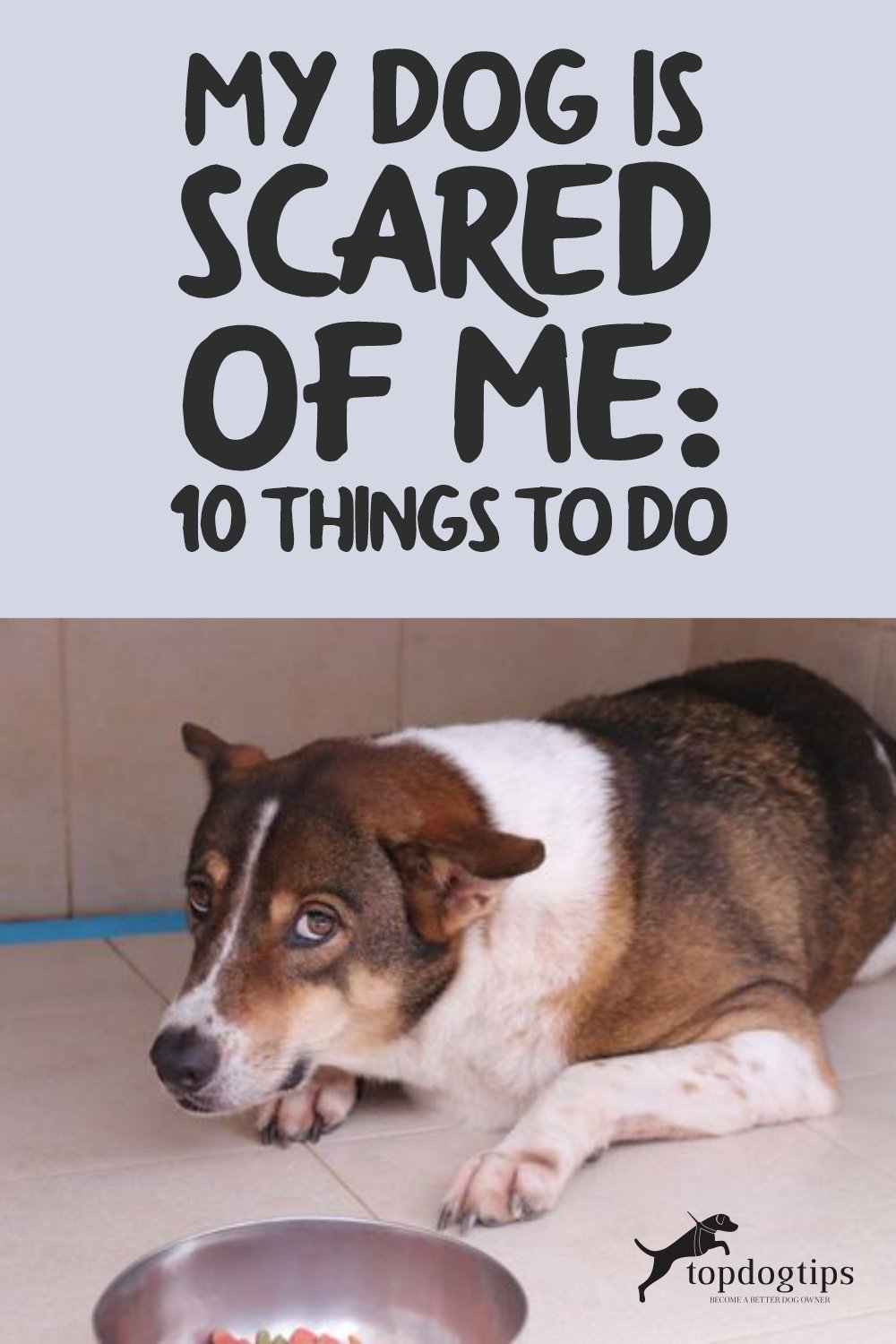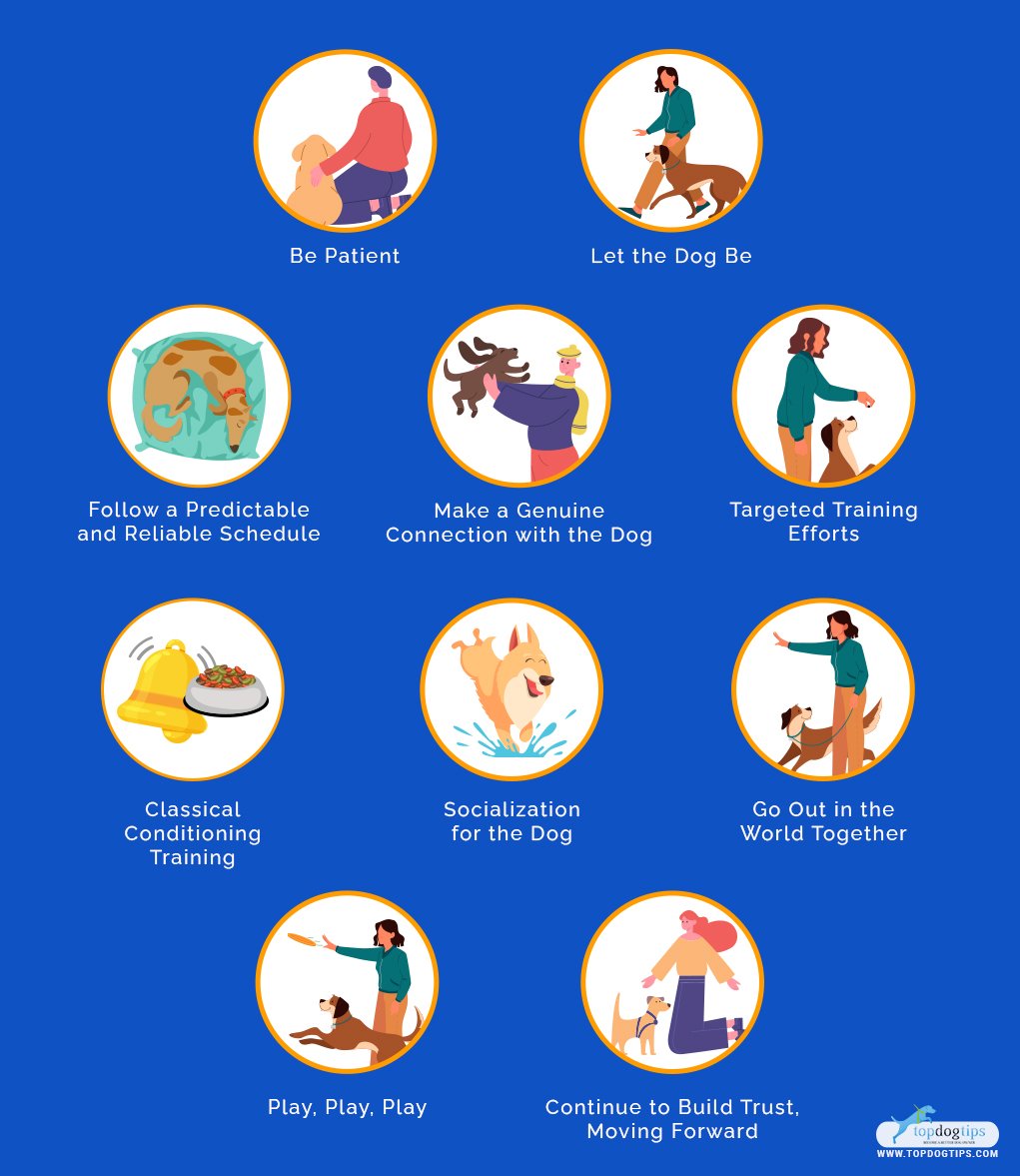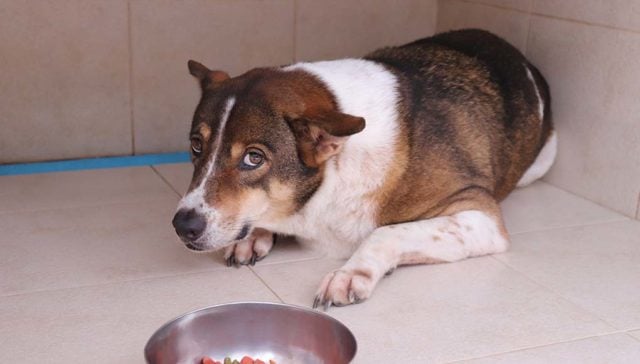
KEY TAKEAWAYS:
– There are different reasons why your dog is scared of you. It could be their past traumatic experiences, frequent accidents, they are shy, or you are scared too.
– If your dog is showing submissive behaviors—tails in-between legs, whale eyes, whining, and fawning, they could be scared of you.
– You can avert this fearful behavior by positive reinforcement, making genuine connection, giving them space, and being patient with them.
– Do not force them or rush them into trusting you; the key here is doing everything slowly, but surely.
Table of Contents
My dog is scared of me. What should I do?
If your newly adopted pup seems to be intimidated by your presence, or your long-time furry pal suddenly starts slinking away when you're around, there's definitely a reason behind that's worth investigating.
When your dog is scared of you, it's not only a devastating feeling. It also becomes increasingly difficult to train, groom, and feed them.
So in this article, let's discuss the common causes why your dog is scared of you and how you can fix it.
Jump to each section:
- Reasons why dogs are scared of their owners
- Ways to know if your dog is scared of you
- What pet owners must do when their dogs are scared of them
- What not to do with a scared dog
- Questions other pet owners often ask
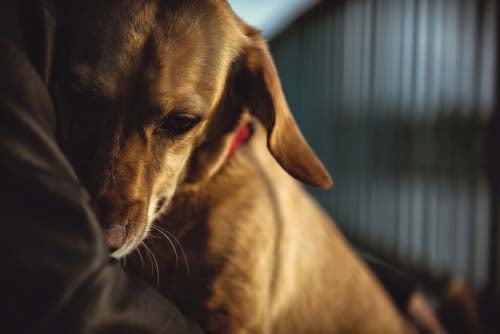
Why is My Dog Scared of Me? 5 Possible Causes
1. Your Dog is Shy
If your dog is adopted, they tend to be shy around new people as they become more used to longer isolation in pet stores or shelters.
There, they were often housed in individual cages, which means they didn't get much socialization with other pets or people.
William E. Campbell, a dog behaviorist and author, said that “the term shy dog should be qualified by examination of the dog's actual behavior and those things that stimulate the shyness.”
Dogs that display submissive behavior may suffer from a punishment syndrome created by overly harsh treatment. Others may suffer from kennelosis or other improper socialization during early critical periods.
Kennelosis means their lack of interest in exploring their new environment.
As long as you make them comfortable in their new environment and give them enough time and space to adjust, they should be up and wagging their tails in no time.
If not, you may also consider behavioral training and socialization, especially if you have adopted an adult or older dog.
Sure, it's difficult to teach an old dog new tricks, so they say, but it's still totally possible!
2. Your Dog was Exposed to Harsh Treatment and Training
Prior to you getting them, it's possible that your dog could also be a victim of harsh treatment by their previous owners.
Physical harm isn't the only harsh treatment they could be scared of. It can also be screaming or raising a voice at them.
The same is true for imposing aversive training on dogs.
Aversive training is a behavior therapy method that involves “adding something to decrease unwanted behavior” (a.k.a. Positive Punishment) and “removing something to increase wanted behavior” (a.k.a. Negative Reinforcement).
It often uses aversive tools like:
- Shaker cans
- Invisible fence collars
- Shock (Electric) collars
- Citronella spray collars
- Prong and choke collars
However, the results show more harm than good in the long run.
According to this study, using these 2 methods at the same time can trigger aggression, fear, and anxiety in dogs in the long run.
What should I do then?
Two words. Positive. Reinforcement. We'll discuss more of this in a bit.
If your pooch has traumatic experiences due to harsh experiences in the past, they'll most likely distrust and fear you too.
Relevant Read: 10 Things Dogs Are Scared of the Most
3. Accidents and Early-Life Trauma
Accidents can happen anytime.
No matter how cautious you are at home, there could be instances when you unintentionally inflict pain on your Fido.
Stepping on their paws and tails while they're asleep is the most common one. I know because this also happens to me and my dog.
Shocking pain can trigger fear and anxiety, especially when it often happens.
Moreover, dogs develop anxiety due to early-life trauma, such as:
- Poor maternal care
- Lack of socialization
Similarly, dogs with adequate exercise regulate noise sensitivity better than canines with less physical activity.
Relevant Read: Best Age to Separate a Puppy from its Mother
4. Your Dog is Exposed to Aggressive Dogs
Generally, a dominance hierarchy is a vital component of animals for a harmonious living and social organization.
And despite the high degree of sociality in canine species, dominance can trigger anxiety in dogs at the lower level of the hierarchy.
In context, dominance in dogs is often established through fights where the winner becomes the leader, and the losers become the subordinates.
Moreover, canines also recognize dominance through ritualized signals, as seen in the following:
With this in mind, fights over dominance lead to injuries and trauma to your dogs.
What should I do if my dog meets an aggressive dog?
When outdoors, it's vital to keep your dogs at a distance and on a leash at all times.
And as a rule of thumb, never force your dogs to meet another dog.
Let them take the lead and take note of their body language.
Note: Neutered dogs can still show dominance and submissiveness at times.
They may growl, stare and bark at, or mount other dogs to exude confidence.
Meanwhile, submissive dogs tend to crouch or run away.
5. Fearful Owners
Do anxious dogs have anxious owners, too?
Well, as applied behavioral ethologist and author Kim Brophey said,
Dogs belonging to high-stress/anxiety clients are often higher than average in their stress levels and exhibit more anxiety or hyperarousal.
Also, according to this study, dogs adapt to their owner's personality, and they tend to be the following:
- Shy
- Tense
- Emotionally unstable
- More underdisciplined
You might wonder why this phenomenon is happening today.
According to social psychologists, people tend to choose friends and romantic partners based on trait similarities.
So, fearful dog owners often project their anxiety on their innocent furry companions.
While pets help relieve stress from their owners, it's vital to note that they're not just emotional sponges.
In a positive light, you can help prevent anxiety in your dogs by engaging in outdoor activities or creating positive vibes at home.
Interesting Read: 25 Creative Dog Parks To Visit In America
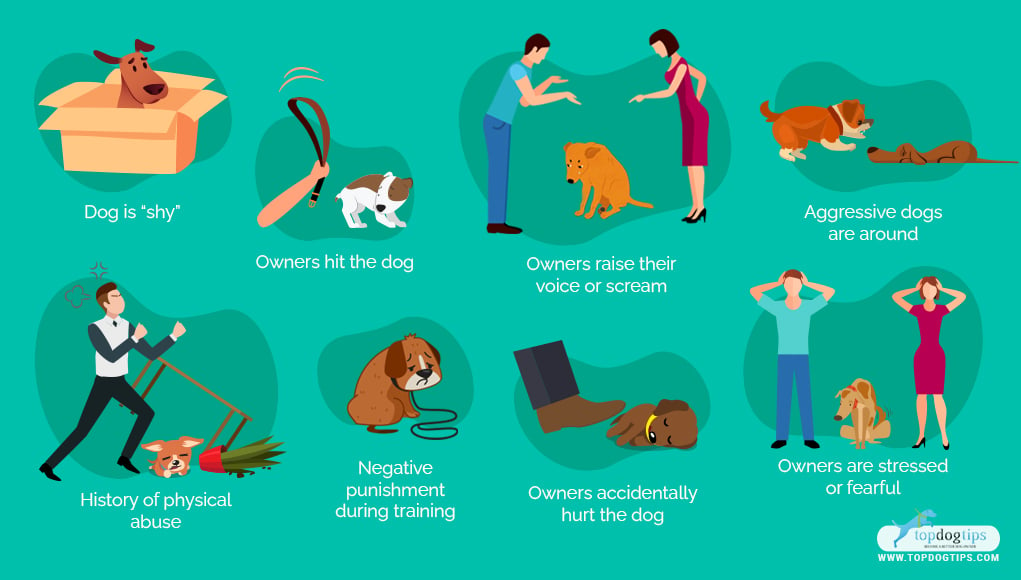
Ways to Know if Your Dog is Scared of You
Dogs show their emotions in a lot of different ways.
So, for your reference, here are some things to look out for when your dog is scared of you:
- Biting
- Pacing
- Whining
- Clinginess
- Licking its lips
- Flattened ears
- Excessive yawning
- Tail between its legs
- Persistent scratching
- Submissive urination
- Not accepting treats
- No eye contact with you
- Leaving the room when you enter
- Raised hair by the back of its neck
- Tracking your movements carefully
And interestingly, a dog who's showing excessive affection to its owner can also be a sign of being fearful. This is called fawning.
Fawning is a dog's attempt to appease a perceived threat which is you, their owner, who they're afraid of.
They may expose their belly while making high-pitched whining to elicit a caretaking response from you.
They may also paw or lick your hands while keeping their tail tucked low between their legs and ears back in a display of anxiety.
Familiarize yourself with some of the things that dogs are most likely to fear.
Although every canine is different, some of the most common phobias are:
- Children
- Car rides
- Loud noises
- Other animals
- Separation from their humans
Even when you think you've been doing all things right, some dogs may still be scared of you for a variety of reasons.
Next, we'll discuss what you can do to fix this problem.
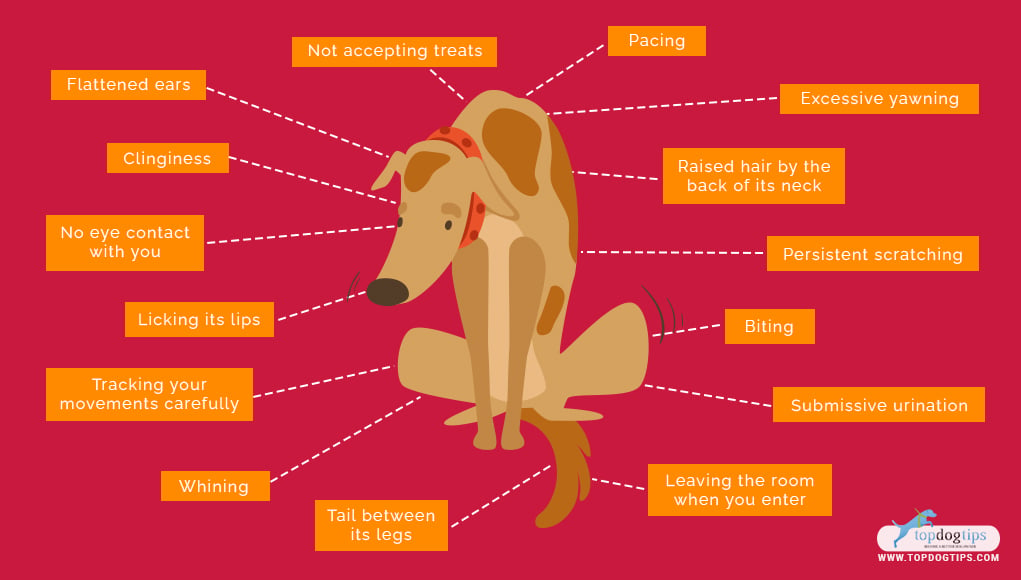
My Dog is Scared of Me: What You Can Do About It
1. Be Patient
Every dog is different, and much like humans, each dog will adapt to its environment and learn at its own pace.
This could take days, weeks, or months of consistent effort and training, depending on the dog's personality and the reason for their fear.
Most dogs will learn to trust their owner(s) and other humans with time and effort.
But it's imperative that you're patient enough and not force them to be angry with your dog during this process.
2. Let the Dog Be
Having their own space and time alone, with less attention and less interaction, is exactly what some dogs need to become comfortable.
Coming on too strong at your dog can be intimidating to them as well.
Sometimes, the best way to gain a dog’s trust is to let them take the lead in deciding when they want interaction with you.
Let the frightened pup come to you for attention instead of you going to them.
Interesting Read: How Owners Lose Their Dogs’ Trust
3. Follow a Predictable and Reliable Schedule
When your dog is frightened and stressed, the hormone cortisol pumps through its body, making matters worse.
One way to help regulate their fear and stress hormones is by creating and following a consistent routine like the following:
- Socialization
- Positive reinforcements
- Regular feeding schedule
- Playtime and outdoor walks
Repeated actions, when done in a calm and non-aggressive manner, will earn your dog’s trust.
4. Make a Genuine Connection with the Dog
Most dogs enjoy pets and belly rubs from you.
Unfortunately, some dogs have been physically abused, and they perceive that human touch is a bad and scary thing.
If this is the case with your dog, you’ll have to get creative and make a genuine connection with the dog in another way.
Giving dog treats during training sessions, when they do what is asked of them, is one of the many ways to connect with your dog.
When you cannot physically touch the dog while praising them, use a positive and soothing tone to tell the dog they're doing great.
Tip: Incorporate a clicker into your training sessions.
When your pup follows your command, make the clicker sound and give their favorite treats immediately.
This lets them associate with a positive experience and will likely repeat the same cue in the future.
5. Targeted Training Efforts
While clicker training works amazingly well for some dogs, others may require additional or other forms of training.
It’s all about trying different methods when working with a fearful dog to find what they're most comfortable with.
When a fearful dog does something bad, instead of punishment, try to ignore them in an obvious manner.
Research has proven that positive reinforcement while ignoring bad or incorrect behaviors is the best method of training fearful dogs.
If you react in any way, they will perceive this as a reinforcement and ‘reward' (especially if they really intend to get your attention.) As a result, Fido will keep doing this unwanted behavior.
Relevant Read: Most Effective Dog Training Methods According to Science
6. Classical Conditioning Training
This training method refers to a psychological experiment named Pavlov’s Dogs, which was conducted by the famous physiologist Ivan Pavlov.
Pavlov discovered that dogs don't need to learn most things in order to thrive.
But, certain reflexes and responses are hard-wired in them.
In Pavlov's experiment, he attempted to measure the dog's saliva in reaction to feeding.
Accidentally, he noticed that his dogs began salivating even from hearing his lab assistant's footsteps while approaching the room.
The dogs knew that Pavlov's assistant carried their food which triggered the same response.
With classical conditioning training, your dog learns to associate one thing with another thing.
When you're around, reward your dog with treats, pets, or praise for calm behavior.
You can reward them for simply seeing you with a happy, relaxed demeanor. Start by just being in the same room, then slowly get closer over time.
Pair your arrival with a happy greeting, treats, or their favorite toy.
Just be very calm and gentle in your movements and voice!
Eventually, your dog will learn your presence predicts positive things.
7. Proper Dog Socialization
It's beneficial if another dog lives at home with you and your scared dog.
But even if you don't have another pooch living with you, proper socialization and exercise are vital for dogs with anxiety.
Going out for walks regularly or enrolling your Fido in a doggy daycare may slowly ignite their sociable personality back.
8. Go Out Together and Explore
Going on hikes or walks in public places is a great start.
If your scared dog is too intimidated by the leash or the outside world, that's normal.
You can start by having playtime and running sessions in your backyard or try some fun indoor activities.
Plus, giving your Fido toys can be something they're interested in.
From plushies to interactive dog toys, be sure to pay attention to which they like and use it to play with them regularly.
9. More Playtime Please
Playing with a scared dog can be a difficult task.
But if you can engage a fearful dog in any play, it will be a great bonding and trust-building experience.
Take things very slowly with a fearful dog to build their confidence in playing with you.
Start with low-pressure games where they control the interaction, like finding treats hidden around the house or gently tossing toys near them without reaching for the toy yourself.
Use high-value rewards consistently to reinforce any interaction with positive associations.
Keep sessions short at first and end on a calm note.
Allow them to approach you and the toy or game at their own pace without pressure.
Lots of patience is key, as is maintaining a calm, relaxed energy to help the dog feel comfortable.
Over time, as they learn play means only good things happen, their natural play drive will come out and they'll gain confidence that playing with you is safe and fun.
It's important to use up their energy in physical activities rather than spending the entire day lying in bed.
10. Continue to Build Trust
Just because you see success in helping your scared dog to become less fearful doesn't mean that you can discontinue all of your efforts.
Doing so will likely reverse all of the positive results that your hard work with your scared dog has produced.
Be consistent in your training, play, and schedule routines.
Additionally, never let an aggressive adult, child, or dog play around your fearful dog.
Do so very slowly when introducing your dog to new situations, experiences, and people to avoid aggression.
Read Next: Dogs and Kids: 17 Rules to Keep Kids and Dogs Safe
Important: Do Not Do This to Your Scared Dog
As much as you want to make them feel comfortable as soon as possible, the key here is slowly but surely.
If your dog is scared of you, here are some things you should avoid doing around them:
- Do not make direct eye contact, as this can be seen as a challenge or threat to some dogs. Avoid staring at them.
- Do not reach toward their face or body abruptly, as this could seem like a potential attack. Slow, gentle movements are best.
- Do not corner the dog or block their potential escape routes. Give space, and don't crowd them.
- Do not use a loud, deep, or high-pitched tone of voice. Speak softly and calmly instead.
- Do not force physical contact or affection if they seem uncomfortable. Let the dog approach you first and learn to trust at their own pace.
- Do not make the dog feel restrained or trapped by leaning over them. Give space and freedom to move away.
- Do not punish or scold fearful behaviors, as this will likely only increase stress and inhibit training progress.
The key is to move and speak in a calm, gentle manner and give the fearful dog space, time, and positive experiences to build confidence in your presence.
Forced interactions will likely backfire.
My Dog Is Scared of Me: FAQs
If you are dealing with a situation like this, the following questions and answers can help summarize all of the above information.
How Do I Get My Dog Not to Be Scared of Me?
To make your dog not scared of you, try to avoid eye contact, stick to glances while petting him, use treats, and be patient.
What Happens If Your Dog Is Scared of You?
If your dog is scared of you, you will be able to tell from his body language. It may hide or cower. It may also tremble, tuck in its tail, or pull its ears back.
Why Is My Dog Scared of Me All of a Sudden?
There are several reasons that your dog may suddenly get scared of you, including phobia. Other possibilities include being sick, past abuse, a traumatic experience, and age-related issues.
What Makes a Dog Scared of Everything?
If a dog is scared of everything, there are several possible reasons why. It can be from lack of socialization, physical or emotional trauma, pain, abuse, neglect, phobia, or other causes.
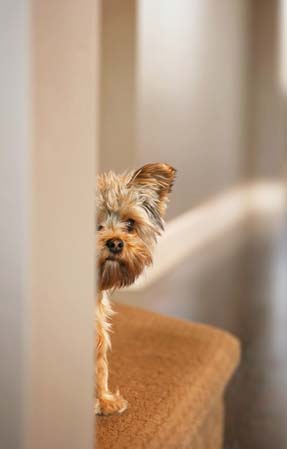
My Dog Is Scared of Me: Before You Go…
How do I get my dog to trust me?
Give your dog plenty of time and space to start to trust you.
Use that time to learn about canine body language so you can read what it isn’t telling you.
Follow the above advice, such as giving your dog rewards for good behavior, playing together, and being patient.
So, if you enjoyed this blog, you might find the following recommendations, too!
READ NEXT:
- How To Deal With Puppy Separation Anxiety
- Why Does My Dog Stink? 12 Reasons Why and What to Do
- 12 Best Dog Anxiety Medications: Over-the-Counter and Calming Supplements For Dogs
